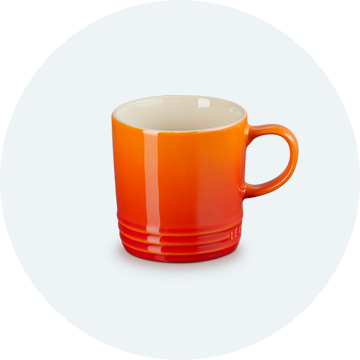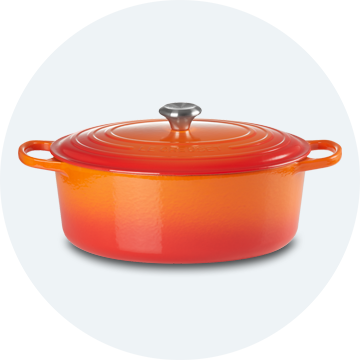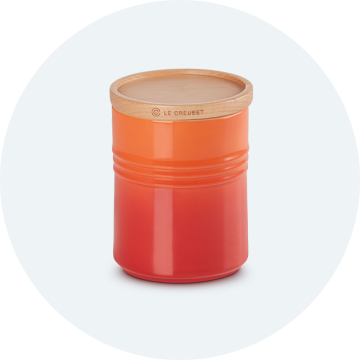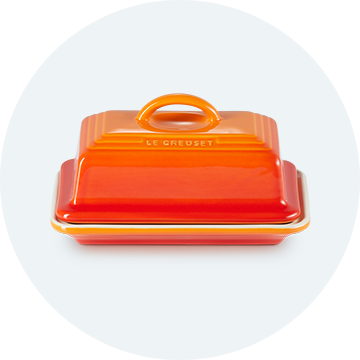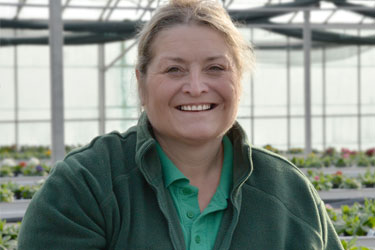
Le Creuset


Discover our great range of Le Creuset cookware, bakeware, dining & cooking essentials, with colours to suit every style!
Shop By Category
Explore the Colours
About Le Creuset
Le Creuset is recognised the world over for market-leading, premium quality ranges of enamelled cast iron cookware, multi-ply stainless steel, toughened non-stick, and stoneware, along with its outstanding range of wine accessories. Established in 1925, Le Creuset has been making world-class cookware for almost 100 years, innovation remains at the forefront of Le Creuset’s success. Used by leading chefs and keen cooks around the globe, Le Creuset cookware offers outstanding performance time after time.
Size Guide
Need a little help? Use this guide to find the perfect fit for your kitchen.
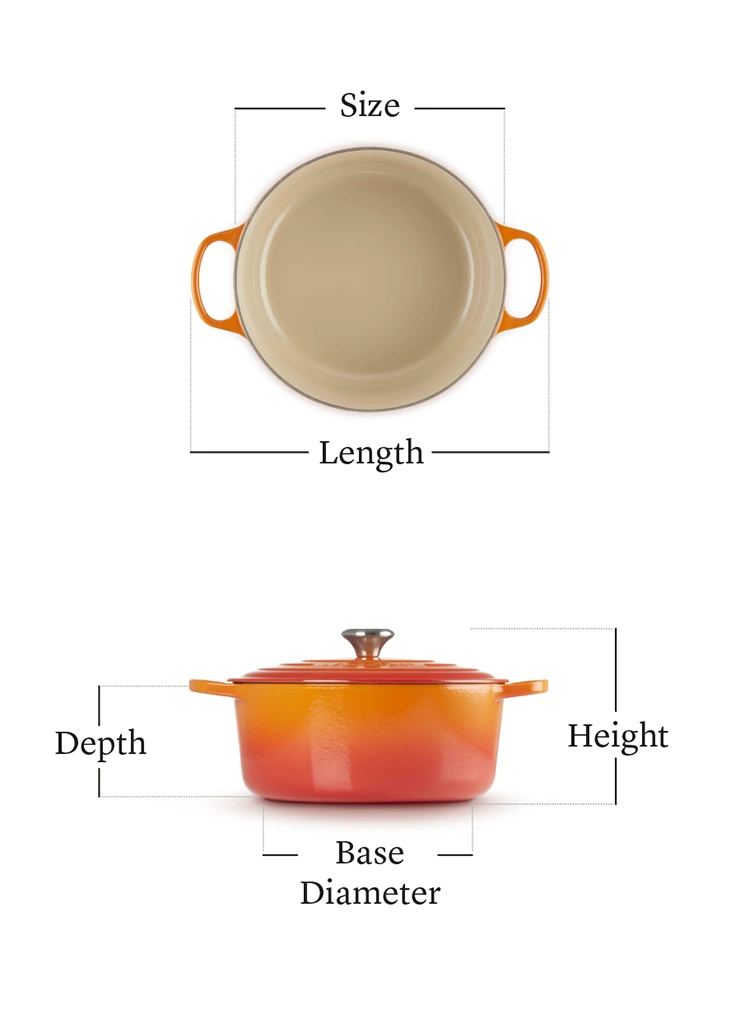 Casseroles
Casseroles
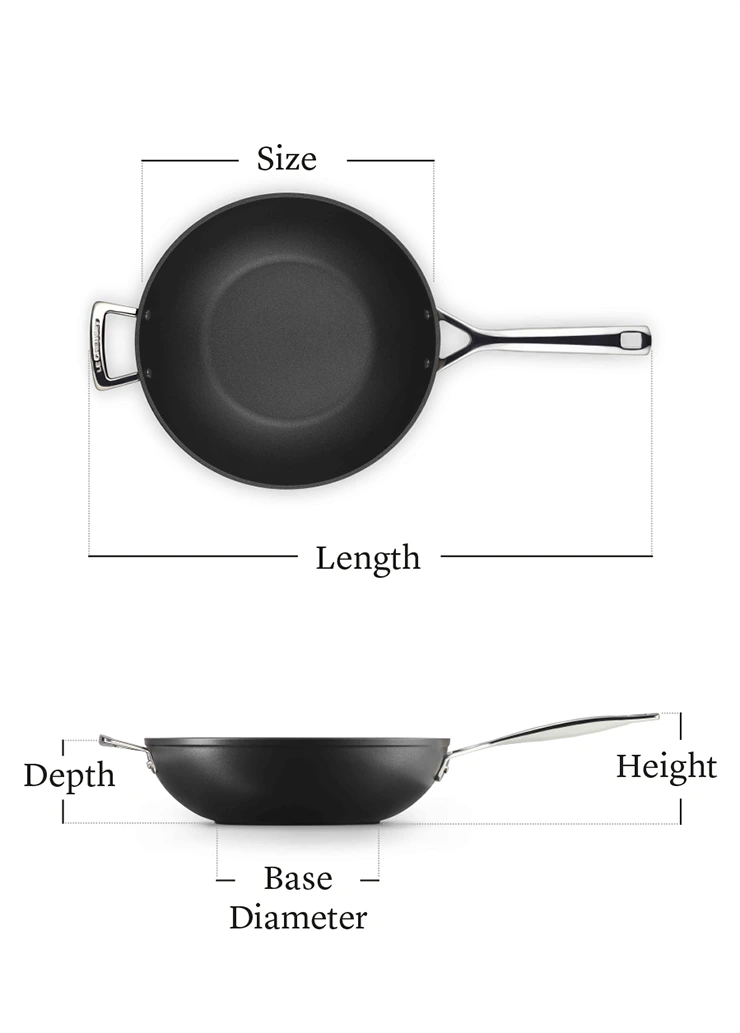 Pans
Pans
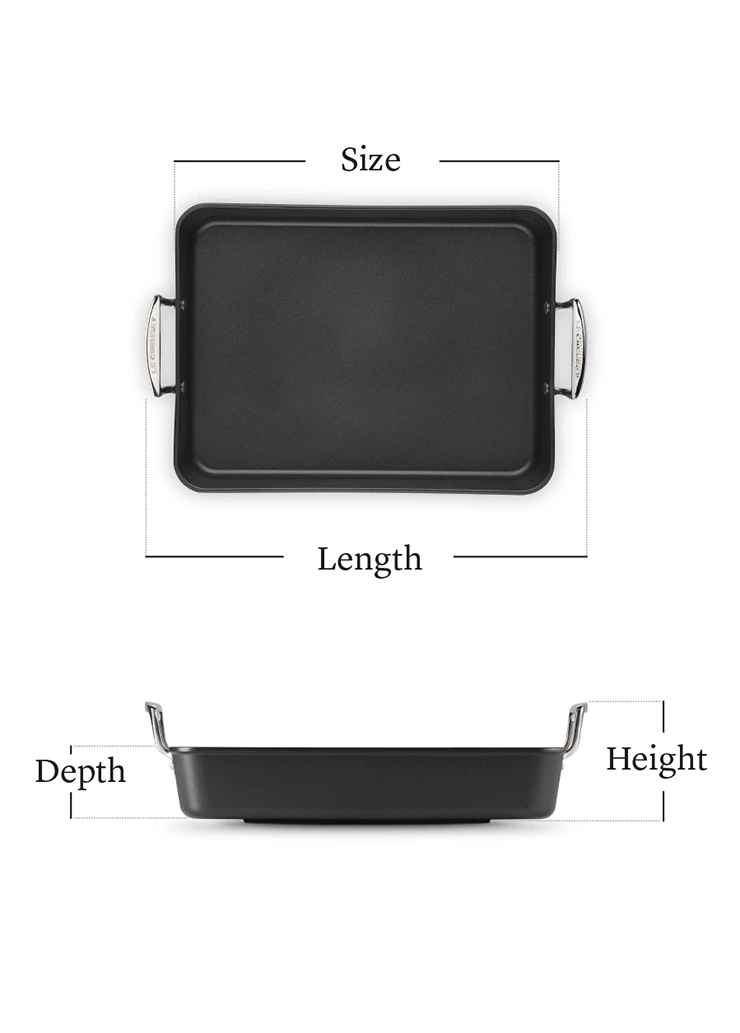 Roaster & Trays
Roaster & Trays
Care & Use Guides
Each piece from our extensive range of high-quality cookware is designed for versatility and ease of use. Please read these care and use guidelines before using your cookware for the first time. The information here will help you achieve the best possible cooking results.
Cooking with cast iron
Enameled cast iron is a remarkable and robust material that performs well with modern requirements for food preparation and cooking. Whether you choose to stir-fry, slow-cook a casserole, sear a steak or bake a cake, there is a shape that is suitable. Cast iron performs well for either slow cooking or high-temperature searing.
Cast iron can be used reliably on any heat source, including induction, and with any oven or grill. It has the ability to retain heat efficiently, which allows for use of lower heat settings in stovetop and oven cooking. On the table, a hot covered dish will keep food hot for second servings.
Cast iron can also be used to keep foods cold. A chilled dish becomes an ideal cold food server on a hot summer day. It can also be placed in the freezer for food storage or advanced food preparation.
Before first use
Remove all packaging and labels. Wash the pan in hot, soapy water, then rinse and dry thoroughly. Your pan is now ready to be used and does not require any further preparation.
Heat recommendations
Le Creuset cast iron cookware can be used on all heat sources including gas, electric solid plate or radiant ring, vitro-ceramic glass, induction, and ovens fired by gas, oil, coal or wood. When using any glass-topped stove, always lift the pan when moving it; never slide it, as this may damage the stovetop or the base of the pan.
Always match the pan’s base size to the stovetop heat zone to maximize efficiency, and to prevent overheating of the pan sides or damage to the handles.
Gas flames must always be confined to the base area, and must never extend around the sidewalls of the pan. Long handles should be positioned safely where they do not hang over the front of the stove or other heat zones.
Cooking heats
Medium or low heat will provide the best results for cooking, including frying and searing. Allow the pan to heat gradually and thoroughly for even and efficient cooking results. Once the pan is hot, almost all cooking can be continued on lower settings.
High heat temperatures should only be used for boiling water for vegetables or pasta, or for reducing the consistency of stocks or sauces. High heats should never be used to preheat a pan before lowering the heat for cooking. Cast iron retains heat so efficiently that overheating will cause food to burn or stick.
Oils and fats
With the exception of Grills, the enamel surface is not ideal for dry cooking.
Your choice of liquid, oil, fat or butter should completely cover the base before heating begins. Do not leave the pan unattended, and do not allow a pan to boil dry, as this may permanently damage the enamel.
For deep frying, the maximum oil level must not exceed 1/3 full. This depth allows sufficient height above the oil for it to rise once foods are added. An oil frying thermometer should be used for safety, and a lid should be readily available in case of overheating or flaring.
Food storage and marinating
The vitreous enamel surface is impermeable and therefore ideal for raw or cooked food storage, and for marinating with acidic ingredients such as wine.
Tools to use
For stirring comfort and surface protection, Le Creuset silicone tools are recommended. Wooden or heat-resistant plastic tools may also be used. Metal tools, spoons or balloon whisks may be used, but require special care – they should not be scraped over the enamel surface. Do not knock these on the rim of the pan.
Hand-held electric or battery-operated beaters should not be used. Their blades will damage the enamel. Knives or utensils with sharp edges should not be used to cut foods inside a pan.
Handles
Cast iron handles, stainless steel knobs and phenolic knobs will become hot during stovetop and oven use. Always use a dry thick cloth or oven mitts when lifting.
Hot pans
Always place a hot pan on a wooden board, trivet or Le Creuset silicone mat—never on an unprotected surface.
Oven use
The black phenolic lid knobs on our Signature range of enameled cast iron are heat-resistant to 480°F / 250°C. The black phenolic lid knobs on our Classic range of enameled cast iron are heat-resistant to 390°F / 200°C. Products with integral cast iron handles or stainless steel knobs are safe for use in a conventional oven up to 260°C. Pans with wooden handles or knobs must not be placed in the oven.
Do not place any cookware on the floors of ovens with cast iron linings. This will increase the cooking temperature inside the oven, resulting in an increased cooking rate with detrimental effects on food. Do not drag cookware across the floor of the liners. For best results always place on a shelf or rack.
Cooking tips for grilling
Grills may be preheated to reach a hot surface temperature for searing and caramelization. This advice does not apply to any other products.
For correct grilling and searing, it is important that the cooking surface is sufficiently hot before cooking begins. Sear lines from ribbed grills will not be produced if the pan surface is too cool, or if the food is too wet. Place the empty pan on medium heat and allow it to heat for several minutes. Do not add oil to the cold pan—the oil may become too hot and smoke.
Take a few drops of water on your fingers and scatter over the hot surface. If they sizzle and evaporate almost immediately it is hot and ready for use. If the water produces steam and has no sizzle, heat the pan a little longer and repeat the water test again. When the surface is hot enough, lightly oil it with cooking spray or brush it with oil using a Le Creuset silicone basting brush. Vegetable, ground nut or corn oils are recommended. Olive oil may cause excessive smoking.
Once a patina covers the cooking surface very little oil will be necessary. For distinct sear lines, leave the food undisturbed on the surface for several minutes. If the food is moved too quickly the lines will be poor, and steam from the food may be released onto the surface.
Any food for grilling or searing must be quite dry before it is placed on the hot surface. Wet foods will not achieve good sear lines and may result in a steamed appearance and flavour. Use paper towels to pat off excess moisture from foods. Oil can then be brushed over the food if desired. Foods that have been marinated should also have excess moisture removed with paper towels.
Cooking tips for shallow frying and sauteing
For frying and sauteing, the fat should be hot before adding food. Bring the pan and fat or oil to the correct temperature together.
Oil is hot enough when there is a gentle ripple in its surface. For butter and other fats, bubbling or foaming indicates the correct temperature. If either begins smoking, or if butter begins browning, it is too hot and should be cooled slightly before proceeding. The quickest way to do this is to remove the pan from the heat source for a few moments. For longer shallow frying a mixture of oil and butter gives excellent results.
Cleaning and Care
General care
Always cool a hot pan for a few minutes before washing.
Do not plunge a hot pan into cold water. While Le Creuset’s enamel is designed to be the most durable on the market, thermal shock may still occur, resulting in cracking or loss of enamel.
If there are food residues, fill the pan with warm water and let soak for 15 to 20 minutes before washing. A brush can be useful for removing small food deposits, or for cleaning between the ribs on grills. Do not use scourers or abrasive cleaners on the cooking surface. Nylon or soft abrasive pads or brushes can be used to remove stubborn residues. To avoid damaging the enamel, do not use metallic pads or harsh abrasive cleaning agents.
Light stains or metal marks caused by metal tools can be removed with Le Creuset cookware cleaner. An occasional cleaning with this product will also retain the new appearance of your pans. It can be purchased on this website or from your local retailer. Never store pans while they are still damp. Store pans in a dry cupboard or airy space away from steam.
Maintain the tightness of all handles and knobs by checking and retightening them regularly.
Le Creuset enameled cast iron is extremely durable but it may be damaged if accidentally dropped or knocked against a hard surface. Please note that this is not covered by our Lifetime Warranty.
Dishwasher use
All pans with integral cast iron, phenolic handles or stainless steel knobs can be washed in the dishwasher. However, constant dishwashing may lead to some dulling of the enamel finish. This is not harmful and will not impair performance. When using the dishwasher always allow the cycle to finish before opening the door. This will ensure the pans are dried thoroughly.
Pans with metal handles can be washed in the dishwasher, but this greatly reduces the development of a patina; as a result, grills and skillets will require oiling for a longer period. Pans with wooden handles are not dishwasher-safe.
Satin Black
Satin Black enamel can be found on skillets, grills, frying pans, saute pans, woks, tagines and a number of round and oval casserole dishes. Satin Black enamel has a smooth feel but is not as glossy as other light-coloured interior enamel finishes. It has been specially designed for higher surface temperature cooking, which is not the same as simply using a piece on a high heat.
With cast iron, higher surface temperatures can be achieved by allowing any piece to heat thoroughly on a medium setting. This makes the satin black interior ideal for frying, grilling and searing.
Satin Black enamel will keep its good looks and allow a patina to build on its surface with continued use. A patina is the result of the natural oils and fats from foods baking on to the hot surface. The patina should not be cleaned off, as it enhances the cooking performance and the release of foods. It also reduces the need for surface oiling.
With the higher surface temperatures achieved during frying, grilling and searing, sugars and some enzymes will cause caramelization. This not only aids in the retention of moisture and flavour, but also produces the sear lines and crusty exterior on grilled meats.
Cooking with Professional Hard Anodised
Le Creuset Professional Hard Anodised pans are made using a high technology, dual-layer material combining a tough, hard anodized aluminium exterior with a premium quality stainless steel interior. A special magnetic steel base makes the pans suitable for use on induction hobs. The dual-layering continues throughout the whole pan ensuring excellent heat conduction performance from base to rim, preventing hot-spots. The hard anodised exterior of each pan is finished with a durable non-stick coating for easy cleaning. The rim of each pan has a specially designed "all-round" lip for drip-free pouring, suitable for left and right handed use. The close-fitting lids make the pans suitable for "reduced-water" cooking helping to retain vitamins and nutrients - see later section for details. Handles are secured with stainless steel rivets.
Suitable for use on all hobs, including induction. They can also be used in all types of conventional oven and, for shallow shapes, under the grill. Oven-safe to 260°C. Energy saving - only medium to low heat is needed for most types of cooking. Dishwasher safe. Stackable to save storage space. Covered by a Lifetime Guarantee.
Before first use
Remove all packaging and labels, wash pans in hot soapy water, rinse and dry thoroughly. When frying in an uncoated pan for the first time or whenever the pan has been cleaned in the dishwasher, prepare the pan as follows:
- Add some vegetable or corn oil so that the base is covered.
- Heat the oil gently and turn the pan to coat the inner side walls.
- Remove the pan from the heat, let it cool and clean with kitchen paper.
- Add some further oil, fat or butter and begin cooking as normal.
- Season the food only after sealing on the hot surface.
- Turn food only when the surface has sealed and it is easily released, reduce the temperature after sealing.
Usage recommendations
The dual-layer construction of the pans means you do not need to cook on high heat settings. Only MEDIUM heat is needed for most cooking, including frying and searing. Always match the diameter of the pan base to the hob heat zone it is to be used on. Gas flames must always be confined to the base area and NEVER extend up around the side walls of the pan. On any glass-topped hob always lift the pan on and off, or across the surface. Never slide the pan as this may cause damage to the pan base as well as to the glass. Never heat an empty pan. Always use a dry oven glove or cloth when handling hot pans during and after cooking. If using salt, always add to hot cooking liquid or food so that it can dissolve thoroughly. Never pour directly onto the stainless steel surface as it may cause pitting. Do not store raw, marinating or cooked foods in the pans. Ingredients may cause damage to the surface. To protect your pans, we recommend using silicone, heat-resistant plastic or wooden tools. However, metal tools, spoons or balloon whisks may be used with care, but should not be used harshly or scraped over the surface. Never knock metal utensils on the top rim of the pan.
Induction Hob Cooking
Always match the diameter of the pan base to the induction hob cooking zone. Using a pan with a small base diameter on too large a cooking zone may result in a weaker magnetic field being created and reduced heat output. In some cases the hob may not "recognise" the pan and no heat will be generated. DO NOT use the boost function for longer than is required to bring the pan's contents to a boil. The boost function should only be used for rapid heating of large quantities of water e.g. for boiling pasta or vegetables During cooking, you may notice some slight noise being generated in the pan by the induction hob. This will not damage the pan or affect cooking performance.
Reduced Water Cooking
The close-fitting lids, even heat distribution and excellent heat retention qualities of Le Creuset Professional Hard Anodised cookware allows cooking with very little liquid. This method is ideal for vegetables and fruit where flavour can be concentrated and nutrients retained. Place the food and liquid into a cold pan. In 16-20cm diameter pans allow 100ml water for a 20-30 minute cook. In a 24cm pan allow 150ml water. Put on the lid and bring to a simmer when steam will be seen escaping around it. As soon as this happens reduce the heat to very low, so that no steam loss is visible. Cook for the required time. Do not lift the lid during the cooking period as steam will be lost and more liquid will be required to replace it.
Overheating
Damage from overheating is instantly recognisable as the stainless steel surface may change colour producing a golden/brown/blue appearance. This is not reversible and cannot be cleaned off. However it will not alter performance in any way.
Cleaning and Storage
Cool pans for a few minutes before washing in hot soapy water, rinse and dry thoroughly or clean in the dishwasher. For more stubborn residues fill the pan with warm water and leave to soak for 10-15 minutes. Do not fill hot pans with or plunge into cold water. Use only soft, nylon pads or brushes for removing stubborn residues. Do not use any harsh abrasive pads or cleaning agents on any of the surfaces as they may cause damage. A proprietary stainless steel cleaner can be used to remove hard water lime scale deposits and other marks from the interior of the pan. It can also be used to condition, polish and protect the inner surfaces and handles. DO NOT use on the exterior non-stick surface. Thank you for your purchase and we hope you will enjoy using your Le Creuset Professional Hard Anodised cookware for many years.
Getting Started
All items in the Le Creuset stoneware range are original ceramic designs and have been hand-crafted, making each piece unique. Due to this uniqueness, there may be slight variations from piece to piece.
Le Creuset Stoneware is safe for use in the microwave, freezer, refrigerator, dishwasher, oven and under the grill (at a minimum distance of 6.5cm/2 ½ inches from the heating element). The maximum oven-safe temperature is 260°C/500°F.
The glazed surface is easy to clean, scratch-resistant and does not absorb colours or flavours. Le Creuset Stoneware is extremely strong and durable, and resists staining, chipping and cracking. The handles, knobs and rims have been designed for a secure, easy-to-hold grip.
Cleaning and care
DO NOT use any Stoneware piece on the stove/hob top or any other direct heat source such as a flame or BBQ.
USE oven gloves for lifting at all times.
OVEN: Maximum oven-safe temperature is 260°C/500°F.
GRILL: When using under the grill allow a gap of no less than 6.5cm/2 ½ inches between the top of the dish and the heat source/element.
MICROWAVE: Handles may become hot during prolonged microwave use, especially if the handles are enclosed with plastic wrap. Cover just the open top of the dish, leaving the handles exposed.
FREEZER-TO-OVEN USE: DO NOT place a frozen dish of food in a pre-heated oven. Place the frozen dish in a cold oven and set the temperature, allowing the dish and oven to heat up together. Before serving always check that the centre of the food is completely and uniformly hot.
CLEANING: Before the first use, remove labels, wash the dish in hot, soapy water, and rinse and dry thoroughly. For most day-to-day cleaning, cool the empty dish for a few minutes before washing and drying, or wash in the dishwasher, allowing the full cycle to complete. Never leave a dish fully immersed in water. For removal of stubborn residues allow the dish to cool, fill with warm, soapy water and allow it to soak for 10 to 20 minutes. Wash in the usual way using a plastic brush or sponge scouring pad if necessary.
Cooking with Signature Stainless Steel
Le Creuset Signature Stainless Steel pans are made using a high technology, triple-layer system. An aluminium core is sandwiched between two layers of premium quality stainless steel which includes special magnetic steel making the pans suitable for use on induction hobs. The multi-layering continues throughout the whole pan ensuring excellent heat conduction performance from base to rim preventing hot-spots. Some items have a tough, reinforced non-stick coating. This provides a long-lasting, easy to use, durable cooking surface. When used correctly on MEDIUM and LOW heats it will provide excellent performance, releasing foods and residues easily. It is an ideal surface for healthier cooking with very little oil or fat.. Handles are secured with stainless steel rivets.
Before first use
Remove all packaging and labels, wash pans in hot soapy water, rinse and dry thoroughly. For items with a non-stick coating we recommend conditioning the non-stick surface before using for the first time. Rub a film of vegetable or corn oil over the entire cooking surface using a pad of kitchen paper towels. Rinse with hot water, dry thoroughly. The pan is now ready for use. Occasional re-conditioning after this will help to protect the surface and promote longer life. When frying in an uncoated pan for the first time or whenever the pan has been cleaned in the dishwasher prepare the pan as follows:
- Add some vegetable or corn oil so that the base is covered.
- Heat the oil gently and turn the pan to coat the inner side walls. Remove the pan from the heat, let it cool and clean with kitchen paper.
- Add some further oil, fat or butter and begin cooking as normal.
- Season the food only after sealing on the hot surface.
- Turn food only when the surface has sealed and it is easily released.
- Reduce the temperature after sealing.
Usage recommendations
Le Creuset Signature Stainless Steel pans are suitable for use on all hobs, including induction. They can also be used in all types of conventional oven and, for shallow shapes, under the grill. The 3-layer construction of the pans means you do not need to cook on high heat settings. Only MEDIUM to LOW heat is needed for most cooking, including frying and searing. ALWAYS match the pan base size to the hob heat zone it is to be used on. Gas flames must always be confined to the base area and NEVER extend up around the side walls of the pan. On any glass-topped hob always lift the pan on and off, or across the surface. Never slide the pan as this may cause damage to the pan base as well as to the glass. NEVER heat an empty pan. If using salt, always add to the hot cooking liquid or food so that it can dissolve thoroughly. Never pour directly onto the stainless steel surface as it may cause pitting. N.B. Non-stick pans; to protect and prevent damage to the surface, use only MEDIUM and LOW heats for all cooking. NEVER use high heats.
Induction Hob Cooking
Always match the diameter of the pan base to the induction hob cooking zone. Using a pan with a small base diameter on too large a cooking zone may result in a weaker magnetic field being created and reduced heat output. In some cases the hob may not "recognise" the pan and no heat will be generated. DO NOT use the boost function for longer than is required to bring the pan's contents to a boil. The boost function should only be used for rapid heating of large quantities of water e.g. for boiling pasta or vegetables. During cooking, you may notice some slight noise being generated in the pan by the induction hob. This will not damage the pan or affect cooking performance.
Oils and fats
Add a little oil or fat to the cooking surface before heating begins. This will improve the flavour and browning of foods. At no time should the oil or fat be allowed to become smoking hot. If this should occur cool the pan before proceeding.
Fat-free Cooking
When cooking with no added fat or oil, pre-heat the pan on a medium setting for approximately 2 minutes before adding the food. DO NOT leave the pan unattended during this time or allow the dry non-stick surface to overheat as permanent damage may occur.
Food storage and marinating
Do not store raw, marinating or cooked foods in the pans. Ingredients may cause damage to the surface.
Tools to use
To protect your pans we recommend using silicone, heat-resistant plastic or wooden tools in both uncoated and non-stick coated pans. However, metal tools, spoons or balloon whisks may be used with care, but should not be used harshly or scraped over the surface. Never knock metal tools on the top rim of the pan. Knives or utensils with sharp edges should never be used to cut foods on the surface of a non-stick pan. Hand-held electric or battery operated beaters or blenders should not be used on a non-stick surface.
Oven Use
Suitable for use in all types of conventional oven (not suitable for microwave ovens). Oven safe to 260°C.Grill Use
Shallow shapes can be used under the grill. When using a non-stick pan under a hot grill there should be a minimum distance of 5cm between the heat source and the top rim of the pan.
Overheating
Damage from overheating is instantly recognisable. The non-stick surface becomes discoloured and in severe cases detaches from the pan in the form of blistering or peeling.
Scratching
Score marks or severe scratching by heavy use of metal utensils is not covered by the guarantee. Such damage is permanent and will result in the reduction of the non-stick release performance.
Handles
Handles are secured to each pan with stainless steel rivets. Always use a dry oven glove or cloth when handling hot pans during and after cooking.
Hot Pans
Always place a hot pan on a wooden board, trivet or Le Creuset silicone mat; never on an unprotected surface.
Cleaning and Storage
Cool pans for a few minutes before washing in hot soapy water, rinse and dry thoroughly or clean in the dishwasher. For more stubborn residues fill the pan with warm water and leave to soak for 10-15 minutes. Do not fill hot pans with or plunge into cold water. Use only soft, nylon pads or brushes for removing stubborn residues. Do not use any harsh abrasive pads or cleaning agents on any of the surfaces as they may cause damage. A proprietary stainless steel cleaner can be used to remove hard water lime scale deposits and other marks. It can also be used to condition, polish and protect the inner and outer surfaces (do not use on non-stick surfaces).
Cleaning Non-stick Pans
After each use, cool the pan for a few minutes before cleaning then wash thoroughly. The tough, reinforced non-stick coating offers excellent food release and is therefore very easy to clean. To maintain the appearance and performance of the non-stick coating, we recommend washing by hand in hot soapy water rather than cleaning in the dishwasher. This will prolong the life of the non-stick surface and enhance cooking performance. If the non-stick pan is cleaned in the dishwasher: use only domestic strength dishwashing detergent (we recommend non-lemon varieties) the cooking surface should be re-conditioned with vegetable or corn oil before each subsequent use. Please note, prolonged, regular dishwashing may eventually mark or discolour any item of cookware and affect the release properties of non-stick surfaces. This regarded as normal wear and tear and is not covered by the Lifetime Guarantee.
Before first use
Before first use remove packaging, hand wash in warm soapy water and dry thoroughly.
Grease the inside of the tin sparingly before each use for best results.
Oven safe to 240°C/Gas Mark 9.
Metal kitchen utensils may be used, with care.
Knives, or utensils with sharp edges, should not be used.
Cool the tin for a few minutes before cleaning. Do not plunge into, or fill with, cold water when hot.
Hand wash after each use and dry thoroughly before storing.
If washing up water becomes trapped inside the rim, this may cause slight rusting in this area. This is a natural trait of carbon steel, not a fault, and will not affect the performance of the product.
If desired, leave to dry in a warm oven for a few minutes to remove moisture from inside the rim.
Do not use metal or harsh washing up pads/brushes or abrasive cleaning agents on any surface.
Always use protective oven gloves when handling a hot tin during and after cooking.
Not suitable for microwave ovens, dishwasher, grill or use on direct heat.
Lifetime guarantee
Le Creuset offers a Lifetime Guarantee on its non-stick bakeware products.
The guarantee applies from the date of purchase of the original owner, whether a self-purchase or received as a gift.
The guarantee covers faulty workmanship and/or materials when the product is used in normal domestic conditions and in accordance with the care and use instructions provided.
The following are excluded from the guarantee:
To claim under the guarantee please return the product, with proof of purchase, to the place of purchase or contact the free Le Creuset Helpline - see Le Creuset's website.
The guarantee does not affect you statutory rights.
Silicone Tools and Accessories
Le Creuset silicone is an ideal material for kitchen utensils. It is smooth and flexible, and cleanly scrapes both flat and curved surfaces with ease. Silicone will not scratch or damage cookware.
Before first use
Remove all packaging and labels. Wash the utensil or accessory in hot, soapy water. Rinse and dry thoroughly.
Heat recommendations
Le Creuset silicone utensils and accessories are heat-resistant to 482°F/ 250°C, so they are ideal for stovetop cooking. Utensils should not be left in pans while cooking, and handles should not overhang the sides. Heat from the stove can damage the wooden handle.
Cleaning and care
Silicone is dishwasher-safe, so accessories made entirely from silicone can be placed directly in the dishwasher.
To clean wooden-handled utensils simply remove the silicone blade by pulling it from the handle and place in the dishwasher. Wash the wooden handles by hand and dry well before replacing the clean utensil blade.
Mineral oil can be used on the wooden handle after drying to preserve its good looks.
Stainless Steel Tools
Before first use
Remove all packaging and labels. Wash the utensil in hot, soapy water. Rinse and dry thoroughly. Stainless steel tools may also be washed in the dishwasher.
Heat recommendations
Stainless steel tools are safe at any cooking temperature.
Cleaning and care
Stainless steel tools are safe for use in the dishwasher.
Knives
Before first use
Remove all packaging and labels. Wash the utensil or accessory in hot, soapy water. Rinse and dry thoroughly.
Sharpening your knife
A knife with a sharp blade is both easier and safer to use. To sharpen knives with Damascus/damask steel blades we recommend a ceramic pull-through sharpener or ceramic sharpening steel. Knives with regular stainless steel blades can be sharpened with a traditional sharpening steel. We recommend sharpening regularly to maintain the edge. We recommend that knives with a scalloped or serrated edge be sharpened by a professional knife sharpening service.
Cutting surfacesWe recommend cutting on wooden or plastic surfaces only and avoid cutting on hard surfaces like stone, slate, ceramic, marbles or glass as they can damage the cutting edge.
Cleaning your knife
For optimal care we recommend hand-washing your knife in hot soapy water, rinsing and drying thoroughly immediately after use. This will help to maintain its sharpness and avoid damage to the edge. Always keep the sharp cutting edge away from your hand.
Not suitable for the dishwasher.
Storing your knife
We recommend using a knife block or magnetic rack for storage. Kitchen knives should never be stored loose in a draw as the blades may get damaged. Correct storage also helps to prevent injury.
Further Advice
DO NOT use your knife for any purpose other than the preparation of food.
Ensure the knife is always visible. Do not cover with kitchen towels or leave a knife immersed in soapy water.
Always use the appropriate knife for the cutting task.
Never try to catch a knife if dropped.
Always keep knives safely out of reach of children.
Never test the sharpness of a knife by running your finger along the edge.
Salt and Pepper Mills
Cleaning and care
Le Creuset salt and pepper mills should not be immersed in water or put in a dishwasher. If the outside of the mill requires cleaning, wipe with a damp cloth. Let dry completely before refilling. Be careful not to overtighten the knob, as this can damage the shaft and grinding mechanisms.

